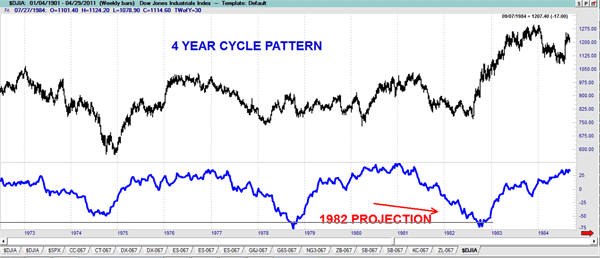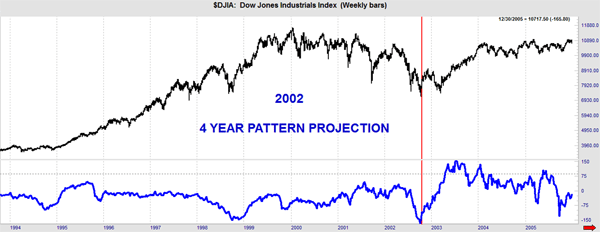Another tool to spot major moves…
Do you want to know…long in advance…
when a market is most likely going to stage a rally or decline?
If so, then you need to know about Seasonal Patterns in Commodity prices.
In 1981 I wrote, “How to Prosper in the Coming Good Years” forecasting a bull market in stocks to begin the next year; it did…the largest in history. In 2001 I wrote another book, “The Right Stock at the Right Time” forecasting a bull market to begin in 2002, that also took place.
Did I just get lucky?
Any market projection that works out certainly includes a good deal of luck. The projection for the 1982 and 2002 market lows was suggested by my four year cycle pattern (which I am reproducing below).
You can see exactly what I saw prior to 1982…the blue line was projecting price to rally upwards at that time. I guess you could say it’s lucky that price rallied, but we had a real good idea back then that prices would do just that.

You can see next how the four-year pattern projected the 2002 market low… again… The blue four-year projection line had been screaming for years (in advance) that a rally would take place at this time. Pretty interesting, wouldn’t you say?

The next chart shows the four-year projection extended out into 2015. So you can get an idea of what is going on in the marketplace. You can see today what should be going on then in the marketplace.

This art of seeing the future began in 1973 with my book, “Sure Thing Commodity Trading, How Seasonal Factors Influence Commodity Prices”. That was the first book-ever- about seasonality and future prices. Since then there has been a plethora of people using seasonal patterns to predict prices.
Let’s take a look at the Copper chart below. What we see is that Copper usually rallies in the first part of the year; not always, but usually sometime in March/April a rally has begun.

There is no guarantee to this… sometimes we get seasonal rallies and sometimes we don’t. What is important is that you are aware of these seasonal patterns so you can use them in your trading decisions.
Let’s say there’s a very strong seasonal tendency for Wheat to rally at a certain time of the year, and as we get there – this year – we see the Commercials are heavy buyers. Would it make sense to go long then? In other words, we can combine these elements with each other for a higher probability of winning.
Let me make this clear… I would not take a trade based on just the seasonal pattern… I use seasonal patterns to confirm other indicators that are suggesting a trade up or down. I also use them to draw my attention to a certain time to check out other indicators, to see what message they are giving us.
In my trading courses I show seasonal tendencies for all the markets. That way you have a quick reference to all actively traded markets.
The ‘take away’ from this lesson is that I am a conditional trader. I look for conditions to be present, not just one, not just the COT Report, but several indicators to suggest the market should move in a certain direction.
In actuality, my students look at, a minimum of, three significant long-term market indicators to be present together to confirm we have a good trade.
Some of the stronger seasonal patterns can be found in the Bond market, stock prices, Gold, Wheat, and Copper. In fact, most of the natural resource commodities (they come from the ground if you will) have strong seasonal patterns. Most of the seasonal patterns I uncovered in 1973 are still working in 2011. This is a very good tool I use to confirm trades or focus time periods to study a market to find big winning trades.
Larry
